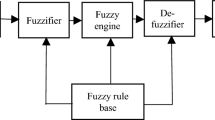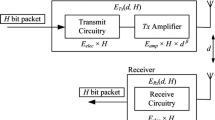Abstract
In wireless sensor networks, the expensive and scarce resources are energy and frequency spectrum. To overcome this scarcity of spectrum, cognitive radio has been introduced in WSNs. The licensed band is utilized by the primary users in cognitive radio whereas the secondary users can use the licensed channels. For improving the network lifetime, overall network scalability, and energy consumption, the clustering technique is used to group the sensor nodes into clusters. Clustering algorithms must be energy efficient because of the difficulties in replacing or recharging the batteries of nodes. While designing the algorithms, more constraints result in the clustering for CRSN as the dynamic spectrum access has been addressed. We propose an energy-efficient fuzzy clustering and congestion control algorithm (EFCCA) in this paper to improve energy efficiency. With the consideration of spectrum availability, queue length, and residual energy, the election of cluster head contributes to the energy efficiency of the algorithm. The active Queue Management algorithm is used to monitor and control the congestion rate. The proposed EFCCA’s performance evaluates with the help of comparison with other clustering methods and it shows enhanced performance in energy efficiency and lifetime based on the outcomes of experimental investigation.










Similar content being viewed by others
Data availability
Not applicable.
Code availability
Not applicable.
References
Mirza Samiulla Beg, D., & Akhilesh, A. W. (2019). A Comprehensive Study in Wireless Sensor Network (WSN) using Artificial Bee Colony (ABC) algorithms. International Research Journal of Engineering and Technology, 6(9), 873–879.
Priya, N., & Pankajavalli, P. B. (2019). Review and future directions of fault tolerance schemes and applied techniques in wireless sensor networks. International Journal of Computational Science and Engineering, 7, 599–606.
Moon, B. (2017). Dynamic spectrum access for the internet of things service in cognitive radio-enabled LPWANs. Sensors, 17(12), 2818.
Bhagat, N., & Malhotra, J., (2017). The issue and challenges in futirisyic development of coginitive radio networks. International Journal of Advanced Research in Computer Science, 8(7), 303–309.
Nayyar, A., Nguyen, B. L., & Nguyen, N. G. (2020). The internet of drone things (IoDT): Future envisions of smart drones. In: First international conference on sustainable technologies for computational intelligence (pp. 563–580). Springer, Singapore
Sahoo, B. M., Amgoth, T., & Pandey, H. M. (2020). Particle swarm optimization based energy efficient clustering and sink mobility in a heterogeneous wireless sensor network. Ad Hoc Networks, 106, 102237.
Dattatraya, K., Navnath, & Raghava Rao, K. (2019). Hybrid based cluster head selection for maximizing network lifetime and energy efficiency in WSN. Journal of King Saud University-Computer and Information Sciences, 34(3), 716–726.
K, Jaiswal. (2019). EOMR: An energy-efficient optimal multi-path routing protocol to improve QoS in wireless sensor network for IoT applications. Wireless Personal Communications, 111(4), 2493–2515.
Özger, M., Alagoz, F., & Akan, O. B. (2018). Clustering in multi-channel cognitive radio ad hoc and sensor networks. IEEE Communication Magazine, 56, 156–162.
Tao, Y., Zhang, Y., & Ji, Y. (2013). Flow-balanced routing for multi-hop clustered wireless sensor networks. Ad Hoc Networks, 11(1), 541–554
Nazir, B., & Hasbullah, H. (2013). Energy efficient and QoS aware routing protocol for clustered wireless sensor networks. Computers & Electrical Engineering, 39(8), 2425–2441
Gherbi, C., Aliouat, Z., & Benmohammed, M. (2016). An adaptive clustering approach to dynamic load balancing and energy efficiency in wireless sensor networks. Energy, 114, 647–662
Eletreby, R., Elsayed, H., & Khairy, M. (2014). CogLEACH: A spectrum aware clustering protocol for cognitive radio sensor networks. In: Proceedings of 9th international conference on cognitive radio oriented wireless networks, ICST, 2014. https://doi.org/10.4108/icst.crowncom.2014.255370
Bhagyalakshmi, L., & Murugan, K. (2014). Avoiding energy holes problem using load balancing approach in a wireless sensor network. KSII Transactions on Internet and Information Systems, 8(5), 1618–1637
Zheng, M., Chen, S., Liang, W., & Song, M. (2019). NSAC: A novel clustering protocol in cognitive radio sensor networks for the Internet of Things. IEEE Internet of Things Journal, 6(3), 5864–5865
Idoudi, H., Mabrouk, O., Minet, P., & Saidane, L. A. (2019). Cluster-based scheduling for cognitive radio sensor networks. Journal of Ambient Intelligence and Humanized Computing, 10(2), 477–489
Vishnu, J. B., & Bhagyaveni, M. A. (2020). Energy efficient cognitive radio sensor networks with team-based hybrid sensing. Wireless Personal Communications, 111(2), 929–945
Bayrakdar, M. E. (2020). Exploiting cognitive wireless nodes for priority-based data communication in terrestrial sensor networks. ETRI Journal, 42(1), 36–45
Pei, E., Pei, J., Liu, S., Cheng, W., Y, Li., & Zhang, Z. (2019). A heterogeneous nodes-based low energy adaptive clustering hierarchy in a cognitive radio sensor network. IEEE Access: Practical Innovations, Open Solutions, 7, 132010–132026.
Gatate, V., & Agarkhed, J. (2021). Energy preservation and network critic-based channel scheduling (EPNCS) in cognitive radio sensor networks. International Journal of Information Technology, 13(1), 69–81.
Zheng, M., Wang, C., Song, M., Liang, W., & Yu, H. (2021). SACR: A stability-aware cluster-based routing protocol for cognitive radio sensor networks. IEEE Sensors Journal, 21(15), 17350–17359.
Shakhov, V., & Koo, I. (2021). An efficient clustering protocol for cognitive radio sensor networks. Electronics, 10(1), 84.
Mukherjee, A., Goswami, P., & Yang, L. (2019). Distributed artificial intelligence-based cluster head power allocation in cognitive radio sensor networks. IEEE Sensors Letters, 3(8), 1–4
Wang, T., Guan, X., Wan, X., Shen, H., & Zhu, X. (2019). A spectrum-aware clustering algorithm based on weighted clustering metricd in cognitive radio sensor networks. IEEE Access: Practical Innovations, Open Solutions, 7, 109555–109565.
Bhagyalakshmi, L., Suman, S. K., & Sujeethadevi, T. (2020). Joint routing and resource allocation for cluster-based isolated nodes in cognitive radio wireless sensor networks. Wireless Personal Communications, 114(4), 3477–3488.
Stephan, T., F, Al-Turjman., & B, Balusamy. (2020). Energy and spectrum aware unequal clustering with deep learning-based primary user classification in cognitive radio sensor networks. International Journal of Machine Learning and Cybernetics, 12(11), 3261–3294.
Tripathi, Y., Prakash, A., & Tripathi, R. (2021). An optimum transmission distance and adaptive clustering based routing protocol for cognitive radio sensor network. Wireless Personal Communications, 116(1), 907–926.
Funding
No funds or grants were received by any of the authors.
Author information
Authors and Affiliations
Contributions
VJ and MVS contributed to the design and methodology of this study, the assessment of the outcomes and the writing of the manuscript.
Corresponding author
Ethics declarations
Conflict of interest
There is no conflict of interest among the authors.
Additional information
Publisher’s Note
Springer Nature remains neutral with regard to jurisdictional claims in published maps and institutional affiliations.
Rights and permissions
Springer Nature or its licensor (e.g. a society or other partner) holds exclusive rights to this article under a publishing agreement with the author(s) or other rightsholder(s); author self-archiving of the accepted manuscript version of this article is solely governed by the terms of such publishing agreement and applicable law.
About this article
Cite this article
Jyothi, V., Subramanyam, M.V. An energy efficient fuzzy clustering-based congestion control algorithm for cognitive radio sensor networks. Wireless Netw 30, 4825–4840 (2024). https://doi.org/10.1007/s11276-022-03143-1
Accepted:
Published:
Issue Date:
DOI: https://doi.org/10.1007/s11276-022-03143-1




